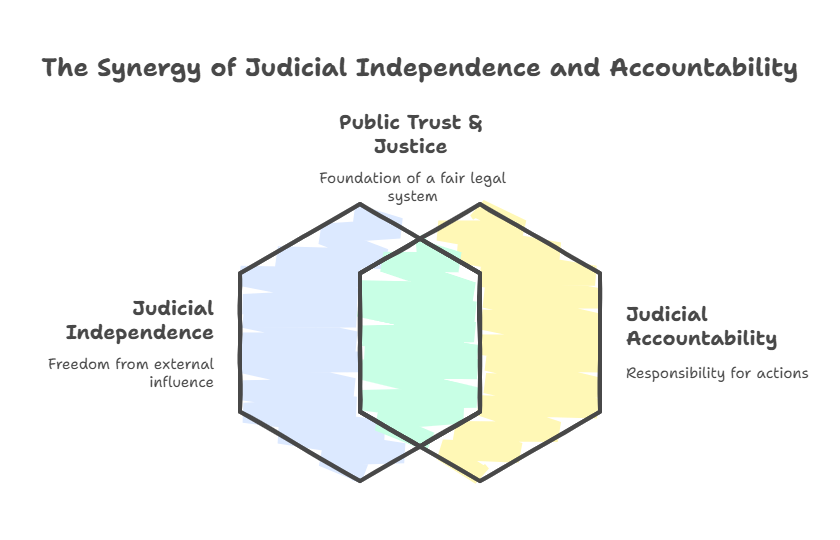- Filter By :
- Polity & Governance
- International Relations
- Social Justice
-
Q. Discuss the challenges in maintaining judicial independence while ensuring judicial accountability in India. To what extent do the existing mechanisms address this tension? (250 words)
08 Jul, 2025 GS Paper 2 Polity & GovernanceApproach:
- Introduce the answer by briefing about Judicial independence and highlight recent current events where judicial accountability was in question.
- Highlight Challenges in Maintaining Judicial Independence While Ensuring Accountability
- Delve into the Extent to Which Existing Mechanisms Address the Tension
- Give Measures to Ensure Robust and Balanced Judicial Accountability in India.
Introduction:
Judicial independence ensures impartiality and safeguards the judiciary from external pressures, while accountability ensures judges act within constitutional and ethical boundaries. The recent move by the Union Government to initiate impeachment proceedings against an Allahabad High Court judge over alleged financial misconduct has once again brought this inherent tension to the forefront.
Body:
Challenges in Maintaining Judicial Independence While Ensuring Accountability
- Ineffectiveness of Existing Accountability Mechanisms: The Judges (Inquiry) Act, 1968, provides for impeachment, but it is complex, rare, and heavily dependent on political will.
- No judge has ever been removed under this process, leading to a perception of institutional immunity.
- Lack of Statutory and Transparent In-House Mechanism: The in-house mechanism created by the judiciary operates without statutory authority and lacks transparency or public scrutiny.
- In serious cases like that of Justice Yashwant Varma, internal investigations remain behind closed doors, raising concerns about effectiveness and impartiality.
- Judicial Independence as a Shield Against Scrutiny: Excessive insulation has led to judicial independence being misused to resist oversight.
- There is no external regulatory body to monitor judicial ethics or conduct, unlike in the executive or legislative branches.
- Opaque Collegium System: The judicial appointment process, controlled by the collegium, lacks transparency and objective criteria.
- This non-transparent system fuels perceptions of nepotism, lack of meritocracy, and limits external checks on performance or conduct.
- Absence of Uniform Standards for Misconduct: No codified or binding Judicial Conduct Code exists, leading to inconsistencies in handling misconduct across courts.
- Disparate and discretionary application of disciplinary measures erodes faith in internal mechanisms.
- Risks of Politicization: Strong accountability mechanisms, if not insulated, can be misused by the executive to influence or punish the judiciary.
- The proposal to bring judges under the Lokpal, though stayed, raises concerns of executive overreach.
Extent to Which Existing Mechanisms Address the Tension:
- Impeachment Offers Theoretical Deterrence but Lacks Practical Teeth: While the Constitution enshrines judicial independence, the impeachment mechanism is too rigid, slow, and politicized to act as a real deterrent.
- The process being invoked for the first time in a High Court case shows its extreme underutilization, despite repeated allegations.
- Internal Mechanisms Offer Control but Lack Credibility: The in-house mechanism provides autonomy, thus safeguarding independence.
- However, the lack of transparency and enforceability limits its ability to inspire public confidence or ensure accountability.
- Lapsed Reforms Reflect Institutional Hesitancy: The Judicial Standards and Accountability Bill (2010) could have introduced an independent oversight committee, but its lapse in Rajya Sabha in 2014 highlights the judiciary’s resistance to external checks.
- Judicial Review as a Check on Lower Judiciary, Not Conduct: Judicial review allows higher courts to scrutinize lower court rulings, but it does not function as a conduct-monitoring tool.
- Allegations of corruption or misconduct often result in quiet resignations, with little or no explanation to the public.
Measures to Ensure Robust and Balanced Judicial Accountability in India:
- Establishment of an Independent Judicial Oversight Body: Create a National Judicial Oversight Committee with statutory authority, comprising retired judges, legal experts, and eminent citizens.
- Empower it to receive complaints, conduct investigations, and recommend disciplinary action, while insulating it from political influence.
- This would provide external checks without compromising judicial independence.
- Revamp the Impeachment Process: Simplify and streamline the procedure under the Judges (Inquiry) Act, 1968.
- Introduce clear timelines, ensure transparency, and provide a public complaints mechanism.
- Make the process less vulnerable to political manipulation, ensuring it acts as a credible deterrent.
- Public Disclosure of Assets and Liabilities: Make annual asset declarations by judges mandatory and public, similar to public servants.
- This increases transparency and helps detect disproportionate wealth accumulation, serving as a preventive measure against corruption.
- Codify a National Judicial Conduct Code: Introduce a binding Code of Conduct that defines ethical standards, conflict-of-interest rules, and expected behavior.
- Ensure that the code is enforceable through an independent mechanism, and periodically reviewed.
- Introduce a Judicial Performance Review System: Periodically evaluate judges on parameters like judicial reasoning, pendency reduction, adherence to ethical standards, and case disposal rates.
- Publish aggregate, anonymized performance reports to maintain public accountability while respecting individual independence.
- Whistleblower Protection in Judiciary: Establish a mechanism for court staff, lawyers, and litigants to report judicial misconduct safely.
- Provide legal protection to whistleblowers from retaliation by the judicial establishment.
- Legislative Revival of Judicial Reforms: Reintroduce and pass the Judicial Standards and Accountability Bill with appropriate checks and balances.
- Incorporate provisions for independent inquiry, public participation, and safeguarding judicial autonomy.
Conclusion:
As former CJI D.Y. Chandrachud aptly said: "True judicial independence is not a shield to protect wrongdoing, but an instrument to secure the fulfilment of constitutional values." Striking the right balance between independence and accountability is essential to preserve the legitimacy and moral authority of the judiciary.
To get PDF version, Please click on "Print PDF" button.
Print PDF





